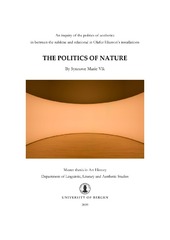| dc.contributor.author | Vik, Synnøve Marie | eng |
| dc.date.accessioned | 2009-07-02T11:20:46Z | |
| dc.date.available | 2009-07-02T11:20:46Z | |
| dc.date.issued | 2009-05-15 | eng |
| dc.date.submitted | 2009-05-15 | eng |
| dc.identifier.uri | https://hdl.handle.net/1956/3325 | |
| dc.description.abstract | This thesis is an inquiry of the politics of aesthetics in between the sublime and the relational in Olafur Eliasson's installations. The Icelandic-Danish artist Olafur Eliasson (b. 1967) is one of contemporary art's most wanted artists. Large exhibitions in recent years, like The Weather Project (2003) in the Tate Modern in London, the retrospective exhibition Take Your Time: Olafur Eliasson (2007) in the Museum of Modern Art in San Francisco (later shown in MOMA in New York) and public art projects as The New York City Waterfalls (2008) has secured his position as one of contemporary art's most central persons. Eliasson's installations, where he often makes use of natures own materials like water soil and moss, or recreates natural phenomena like the sun, a rainbow or a waterfall, are highly seductive and sensual. However, by revealing the underlying construction of the work, thus breaking the illusion, Eliasson encourages reflection, and makes the viewer conscious of herself and her surroundings. This thesis revolves around an aspect of Eliasson's art that has not yet gotten the attention it deserves in the existing research literature; broader analyses of his art in view of the sublime, the relational and the political. My main analyses are of the works Beauty (1993), 360º room for all colours (2002) and Multiple Grotto (2004). How can an enquiry into the relationship between art, nature and politics shed light on Olafur Eliasson's installations? To answer this wide question I will conduct an initial methodical introduction where I discuss whether a sense experience in the spirit of Susan Sontag, or a hermeneutical interpretation in the tradition of Hans G. Gadamer is more applicable to Eliasson's installations. Thereafter I will enquire how Eliassons's might give a sublime experience as Jean Francois Lyotard describes it, before I will discuss whether Eliasson's art is representative of Nicholas Bourriaud's relational aesthetics where the work functions as a catalyst for social situations. These readings will lead to a discussion on whether we might see Eliasson's art as an expression of a political aesthetics, as proposed Jacques Rancière, and finally to Rancière's criticism of the sublime and the relational, as part of the post-modern art scene. | en_US |
| dc.description.abstract | Denne oppgaven er en undersøkelse av politisk estetikk satt opp mot det sublime og det relasjonelle i Olafur Eliassons installasjoner. Den islandskdanske kunstneren Olafur Eliasson (f.1967) er en av samtidskunstens mest ettertraktede kunstnere. Store utstillinger de senere år som The Weather Project (2003) på Tate Modern i London, den retrospektive utstillingen Take Your Time: Olafur Eliasson (2007) på Museum of Modern Art i San Francisco (senere vist på MOMA i New York) og offentlige kunstprosjekter som The New York City Waterfalls (2008) har befestet hans posisjon som en av samtidskunstens mest sentrale aktører. Eliasson installasjoner, der han ofte anvender naturens egne materialer som vann, jord og mose eller gjenskaper naturfenomener som solen, en regnbue eller en foss, er høyst forførende og sanselige. Men ved å synliggjøre verkets underliggende konstruksjon og slik bryte illusjonen, oppfordrer Eliasson til refleksjon og gjør betrakteren oppmerksom på seg selv og sine omgivelser. Denne oppgaven omhandler en side ved Eliassons kunst som ikke har fått den oppmerksomheten den fortjener i den eksisterende forskningslitteraturen; større analyser av hans kunst i lys av det sublime, det relasjonelle og det politiske. Mine hovedanalyser er av verkene Beauty (1993), 360º room for all colours (2002) og Multiple Grotto (2004). Hvordan kan en undersøkelse av forholdet mellom kunst, natur og politikk kaste lys på Olafur Eliasson‟s installasjoner? For å svare på dette omfattende spørsmålet foretar jeg en innledende metodisk introduksjon, der jeg diskuterer hvorvidt en sanseopplevelse i Susan Sontags ånd eller en hermeneutisk fortolkning i Hans G. Gadamers tradisjon er mest hensiktsmessig i forhold til Eliassons installasjoner. Deretter undersøker jeg hvordan Eliassons kunst kan gi en sublim opplevelse, slik Jean-François Lyotard beskriver det, før jeg videre diskuterer om vi kan se Eliassons kunst som representant for Nicholas Bourriauds relasjonelle estetikk, der verket fungerer som en katalysator for sosiale situasjoner. Disse lesningene fører frem til en diskusjon om hvordan vi kan se Eliassons kunst som uttrykk for en politisk estetikk, slik den blir lagt frem av Jacques Rancière, og videre til Rancières kritikk av det sublime og det relasjonelle som deler av den postmoderne kunstscenen. | no_NO |
| dc.format.extent | 2381183 bytes | eng |
| dc.format.mimetype | application/pdf | eng |
| dc.language.iso | eng | eng |
| dc.publisher | The University of Bergen | eng |
| dc.subject | Eliasson, Olafur | nob |
| dc.subject | Politisk estetik | nob |
| dc.subject | Installasjonskunst | nob |
| dc.subject | Relasjonell estetikk | nob |
| dc.subject | Det sublime | nob |
| dc.title | The Politics of Nature An inquiry of the politics of aesthetics in between the sublime and relational in Olafur Eliasson's installations | eng |
| dc.type | Master thesis | |
| dc.rights.holder | Copyright the author. All rights reserved | |
| dc.rights.holder | The author | eng |
| dc.description.degree | Master i Kunsthistorie | |
| dc.description.localcode | MAHF-KUN | |
| dc.description.localcode | KUN350 | |
| dc.subject.nus | 713203 | eng |
| dc.subject.nsi | VDP::Humaniora: 000::Kunsthistorie: 120 | |
| fs.subjectcode | KUN350 | |
